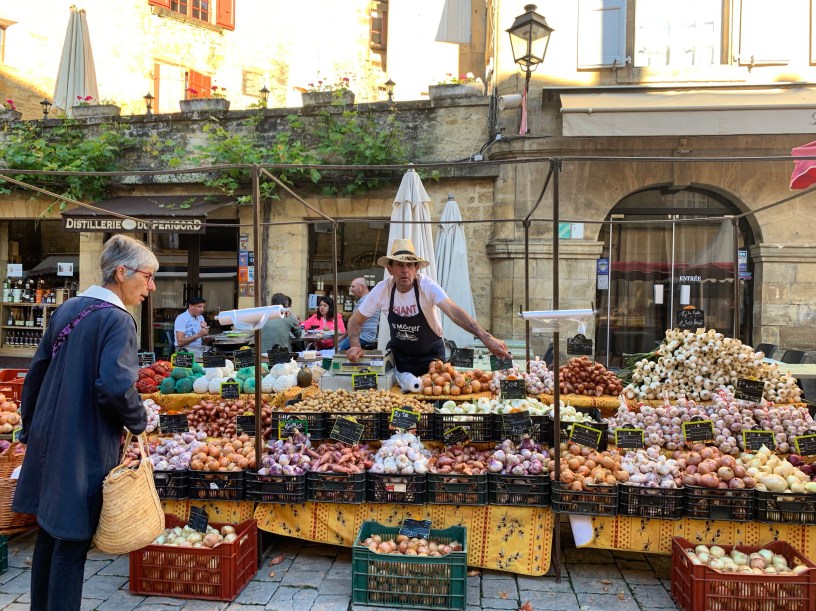Bruno, Chief of Police lives in the fictional town of St Denis in the Perigord region of France, and is the central character of a series of best-selling books by English writer Martin Walker. When not keeping order in St Denis, Bruno cooks, grows his own vegetables and organises the various festivities around the town. He is passionate about food and is always trying to outwit visiting EU food inspectors, so that the townsfolk can continue to make their Fois Gras, cheese, sausage and other local produce, as they did long before the EU existed.
Bruno is the reason I am spending a fortnight in the Perigord region, beginning with a week in Sarlat-la-Caneda – or Sarlat as it is more commonly known. I am travelling with a friend who is an avid fan of the Bruno series. When planning this trip I suggested we stay somewhere in rural France. “I known exactly where we should go, she replied. “Bruno country!” And I’m so very pleased she did.
Sarlat sits in the Perigord Noir region of south-west France and is one of the most charming towns I’ve ever visited. It was established in the ninth century by Benedictine monks and most of the buildings in the old town centre were built between the 14th and 18th century. By the end of the Second World War, Sarlat was largely forgotten and had become derelict, with no running water, power or sewerage. Andre Malraux, a writer, resistance fighter and politician, legislated to restore the town to its former glory while he was Minister of Culture in the 1960s. Sarlat is now a thriving market town and very popular tourist destination.
Every Wednesday and Saturday, the town square – Place de la Libertie – is filled with market stalls selling local produce. The area specialises in Fois Gras, truffles, sausages, ducks, geese, walnuts, strawberries, mushrooms (cepes and chanterelles) and nougat. At the market you can taste and buy all of these products in many different ways. Walnuts are turned into Vin De Noix (walnut wine) or a delicious Gateaux aux Noix (walnut cake). There is even walnut flavoured honey. Sausages are fresh or dried and come in many flavours. The dried sausage is sometimes stuffed with Fois Gras which is delicious. Duck breast is sold fresh, confit style (preserved in fat), or dried coated in black pepper or pimento. At one end of Place de la Libertie is the Marche Couvert (covered market), open every day. It is located in the old Eglise Sainte Marie church – redesigned in 2001 by France’s most famous architect, Jean Nouvel, who was originally from Sarlat. The building has two stunning 15m high dark-grey metal doors, weighing more than two tonnes. Painted on the back of the doors is a great quote from the French philosopher Jean Baudrillard ‘L’architecture est un melange de nostalgie et d’anticipation extreme‘ which translates to ‘Architecture is a mix of nostalgia and extreme anticipation’. Nearby, and watching over the town square, is the bronze Le Badaud de Sarlat, created by a local sculptor Gerard Auliac – apparently to counter local criticism that the covered market should have been designed by an architect that lived in the area. Small town politics at play. During our week in Sarlat, the townsfolk celebrated Journées du Terrior, a two-day festival devoted to local produce and farming. Place de la Libertie and the surrounding streets were again filled with market stalls, but this time there were also cows, donkeys, sheep, geese, ducks, horses, pigs, turkeys, chickens and rabbits. A wandering brass band entertained the crowds and there was the usual jumping castle, face-painting and balloon creations for the children. It was a hugely popular event. Tomorrow we leave Sarlat and move to the much smaller town of Saint-Leon-sur-Vezere, where we’ll spend a week walking, cycling, swimming and exploring a different part of the Perigord Noir. Bruno may not be real, but we sure are enjoying his way of life.









































Hey Michelle … read this post when you posted it. I just asked N what he was reading now (he devours books at a cracking pace). His reply … Bruno Chief of Police!!! And I remembered your blog post! A bit of twaddle for you. Enjoying France … I can tell! A
LikeLiked by 1 person
Hi Amanda. What a coincidence!! Apparently there are about 10 books in the series so far. Looks like you’re enjoying being back on the water. I’m on my way to Preveza today to get our boat organised. Can’t wait to be sailing again. X
LikeLike